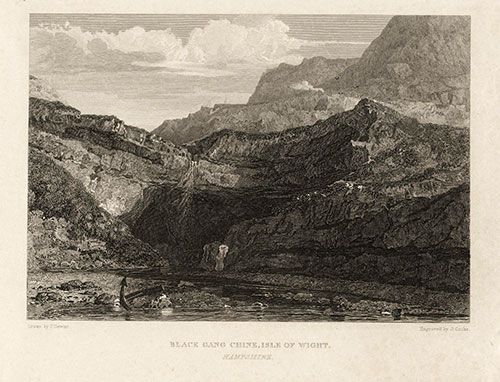Impressions from a Lost World: The Discovery of Dinosaur Footprints
Geological Wonders of Southern England

Black Gang Chine on the Isle of Wight. By the 1840s, it was a tourist attraction. Very little of the original geological formation, a coastal ravine, remains today. Image courtesy of Victoria and Albert Museum Department of Prints and Drawings and Department of Paintings, Accessions 1928.
When Edward and Orra Hitchcock visited the Isle of Wight in 1850, the south coast of England already had a reputation for its geology. Early in the century, in the seaside town of Lyme Regis less than 90 miles to the west, Mary Anning and her father and brother had discovered numerous fine ichthyosaur and plesiosaur skeletons in the “blue lias” cliffs, layers of limestone and shale, mudstone, or clay. Mary sold these specimens to scientists, museums, and moneyed aristocratic and middle class collectors to show off in their cabinets of curiosity.
The coastal rock sequence is a nearly complete, continuous record of approximately 185 million years of earth’s history, the Mesozoic Era, which encompasses the Triassic, Jurassic, and Cretaceous periods. The Jurassic section is especially rich in ammonites, whorled shells shaped somewhat like snail shells, that are the fossilized remains of marine creatures that once thrived at the bottom of the ocean, ranging in size at this location from a few millimeters to two feet across, although even larger ones from later periods can be found elsewhere in the world.
The Isle of Wight formed just off the Jurassic Coast much later. It is made of sedimentary rock—sandstones, shales, mudstones, siltstones, and limestones—built up over millions of years during the Cretaceous and Paleogene ages. The Hitchcocks made tours around Alum Bay, the Needles, Black Gang Chine, and Freshwater Bay. Alum Bay is a misnomer, as true alum (made of aluminum and iron) is not found there. The bay is composed of conglomerates, sands, and clays from the Eocene period and white chalk from the Cretaceous that extends in a ridge into the water, ending in the broken pieces called The Needles. The white sand cliffs on the shore are striped, stained red by ferric hydroxides, green by glauconite, orange by limonite, dark brown, and black lignitic coal. By long tradition, tourists collect little vials of the colored sand to take home. There was formerly a tall and slender "needle" called "Lot's Wife," which toppled into the bay in the late 1700s, sending shock waves as far as Portsmouth on the coast nearby.
Black Gang Chine has been destroyed by erosion, and the wild-looking spectacular ravine is now gone. Even when the Hitchcocks were there, though, it was not wilderness but a theme park, opened as such in 1843. Today's updated version has pirates, fairies, cowboys, and animatronic dinosaurs. Erosion has forced the park's operations further and further back from the beach.
It is possible to walk the whole 630 miles of the South West Coastal Path, the longest such trail in England, which includes the 95 miles of the Jurassic Coast, now a UNESCO World Heritage Site. Parts of the trail are paved paths, while more rugged parts traverse ravines and rivers. Local organizations organize fossil hunting trips. As a natural landscape, it is still liable to occasional rock falls and landslips.